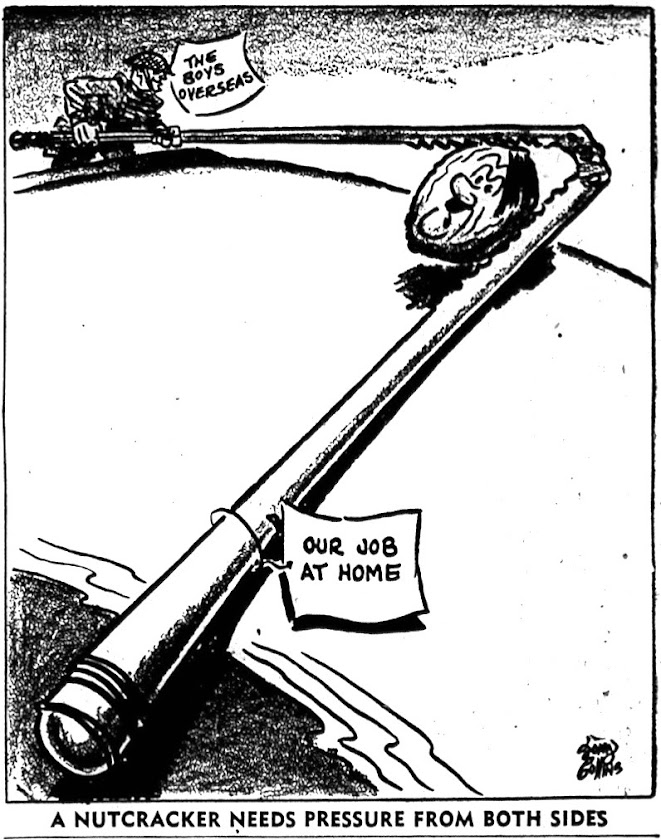Little Known Stories of Canadians in Combined Operations
Building His Website For Almost Seven Years
Eight Ontarians from the first two divisions of Canadian sailors who volunteered
for Combined Ops, at HMS Northney, Hayling Island, England, in February 1942.
Left to Right: Al 'Addy' Adlington, London; Joe Spencer, Toronto; Chuck Rose,
Chippawa; Doug Harrison, Norwich; Art Bradfield, Simcoe; Don Linder, Kitchener;
Joe Watson, Simcoe; Jake Jacobs, Ontario. (Submitted by Gord Harrison,
with permission from Joe Spencer)
The following online news article about my Combined Operations site came about after I contacted CBC reporter Angela McInnes prior to Remembrance Day November, 2021. I called, Angela answered, and I commenced to provide a few details re the archive. She was interested, called back later for a lengthy interview and the rest is history. Part of the interview became part of CBC Radio coverage of Remembrance Day (I've been told that I have a great face for radio!) and the online story became part of CBC News website.
It follows below:
Gord Harrison has been building his website for almost seven years
It began in November 2010.
Retired elementary school teacher Gord Harrison, 72 (at time of interview), was sifting through a filing cabinet of written material left behind by his late father, Doug.
Doug had written numerous columns for his hometown's newspaper, The Norwich Gazette, throughout the 90s. For a time, he had served as president of that area's Legion. Harrison's hope was to add something pithy for his own community newspaper column dedicated to that year's Remembrance Day.
Instead of a quote, Harrison discovered a brown Manila folder he hadn't seen before. Inside were 45 pages of handwritten notes detailing Doug's career as a volunteer reservist for the Canadian Navy during the Second World War.
Before then, Harrison thought he knew everything there was to know about his father's life during that time.
Canadians in Combined Ops 'at their ease' aboard ocean-going vessel with their
landing crafts hanging from davits. Left to Right (back): unknown; C. Powers;
Lloyd Evans, Ottawa; Don Westbrook, Hamilton. Left to Right (front): Don
Linder, Kitchener; unknown; Doug Harrison, Norwich (From the collection
of Lloyd Evans. Submitted by Gord Harrison)
"I actually thought he was in the Merchant Marine, and that was a big mistake," said Harrison. "He had a different type of career than I imagined. Natural curiosity took over."
According to Harrison, Doug was one of a small percentage of Canadian men enlisted in the Royal Canadian Navy Volunteer Reserve who took on special duties in Combined Operations in the 1940s.
The Combined Operations Command was a British offensive organization combining the army, navy and air force.
From 1941 to 1945, Doug took on duties that included landing craft or barges directly on hostile shores during dangerous raids and invasions of North Africa, Sicily, Italy and Normandy, France. He wasn't a part of the Dieppe Raid, but many of his contingent were, including Londoner Lloyd G. Campbell.
"[My father] was so angry. He had lost his mates, you know, and I think that survivor's guilt and anger lasted a long, long time," said Harrison.
A Canadian flotilla of landing crafts approach Valetta's Great Harbour, Malta
after the invasion of Sicily; Photo taken in August, 1943. (Submitted by Gord
Harrison, with permission from Joe Spencer)
"It's helped me form this vision in my head of what history is like," said Harrison. "It's like a jigsaw puzzle that's alive.”
The website has helped him to connect to veterans and memoirists as far as Scotland and Sicily. As part of his research, Harrison has traveled across the country several times to visit the Combined Operations training school on Vancouver Island.
His work led him to find a previously unseen photo of his father belonging to the Imperial War Museum. It also helped to reconnect him to his father's lost duffel bag, which had wound up in the hands of a collector in Ottawa.
"He just typed in the name that was on the duffel bag and the volunteer number, and it led him to my website," said Harrison. "It was kind of a happy occasion on Father's Day of this year."
Gord Harrison, son of Doug Harrison, happy to open this gift on Father's Day,
2021, from a collector of militaria. The collector had purchased an assortment
of military items many years ago in Hamilton and it included Doug Harrison's
WWII navy duffel bag. It depicts film star Betty Hutton in a bit of Navy blue.
(Submitted by Gord Harrison)
Most recently, a filmmaker reached out to Harrison for help in researching the invasion of Italy. Harrison's father was involved in that operation for 30 days.
He plans to make a trip overseas to share what he's learned about what it was like for the Canadians who landed crafts on those beaches.
"It's a feeling of accomplishment," he said. "I'm kind of in the story. My dad's in the story. It's kind of nice to be able to have that connection between my dad and I."
My trip to Sicily is upcoming. I will easily find GEORGE Beach at modern day Fontane Bianche and perhaps be also able to locate the cave in which 50 - 60 Canadian sailors survived for a few weeks during Operation Husky (beginning July 10, 1943, 80 years ago this month).
If I find the cave (aka 'The Savoy' to Canadian sailors) readers will learn about it here first. Unless it hits CBC News!
[Please click here to learn more about research re my trip to Sicily (1)
Stay tuned, I say.
Please click here to view another article that features details about Combined Operations.
Please click here to view another article that features details about Combined Operations.
Unattributed Photos GH





.jpg)
.jpg)

.jpg)
.jpg)
.jpg)
.jpg)
.jpg)







.jpg)
.jpg)
.jpg)

.jpg)
.jpg)
.jpg)


.jpg)








































